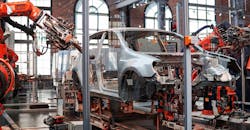Experts Expect More Tech in Post-Pandemic Plants
Supply-chain and manufacturing experts at Purdue University's Krannert School of Management write that manufacturing operations will have to adopt new personnel assignments, new cleaning and maintenance practices, and new sensors and automation systems once they resume regular operations, according to the authors of "Managing Manufacturing Through Covid-19, a TP3 Framework", a working paper researched by the staff of the school's Dauch Center for the Management of Manufacturing Enterprises (DCMME).
While typical manufacturing operations "will look strikingly different in the post-pandemic era, “we’re really bullish on the future of manufacturing,” according to Ananth Iyer, senior associate dean at Krannert and director of DCMME. “We want manufacturers everywhere to come out swinging because that’s the only way the supply chain will ramp back up. And, we actually think that, however bad the pandemic gets, there is a bright future.”
Iyer and his co-authors surveyed senior managers at about 50 manufacturers in Indiana, and the results show that rigorous infection control, social distancing enforcement, and technology expansion offer "a framework for pandemic recovery"
Infection control and social distancing — Many manufacturers are undertaking "value-stream mapping" to optimize labor processes and material flow as they restart operations. By incorporating COVID-19 social distancing practices into their planning process, producers expect to mitigate the chance of workers becoming infected.
“Without a good map of your processes, where the workstations are, and what people are doing, you really don’t have a good way to systematically understand what the health risks are for this infection,” according to co-author Roy Vasher said. “You have to know how many people are standing within six feet, how many people are touching a surface, and how many people are handling the same tools.
"Without understanding these risks, then you don’t know what mitigation to apply.” Vasher added.
To address those health risks, manufacturers are requiring their employees to wear gloves; cleaning and disinfecting tools; and spacing workstations six feet apart by outlining squares or circles on factory floors. Also, they are minimizing the number of employees per shift, increasing the number of shifts per day, and staggering the start time of shifts, all to eliminate the chance of workers coming into close contact with each other.
Technology — Instituting these infection control and social-distancing measures will increase labor costs because plants will have to track workers more closely, run smaller shifts, and ramp up their cleaning protocols. These requirement will lower the threshold for businesses to adopt new technologies, to simplify processes and increase production.
“Given that is the case, it is absolutely the right time to think about adopting technology because what was not justifiable before, becomes justifiable now,” Iyer said. “Technology providers will further decrease costs with increased adoption, so even smaller companies should really be thinking about this.”
For example, Ford is testing wrist bands that sense and alert workers when they are within six feet of a co-worker. More new technologies are likely to be ahead, Iyer added.
“These days, for counting and checking inventory, drones have become common. Cobots can help complete tasks that require two people, and cleaning robots are becoming commonplace for manufacturers,” he said.
“Fast adoption of lots of new technologies could be the way that companies can both protect their employees while continuing to produce and adhere to their new processes,” Iyer said.
